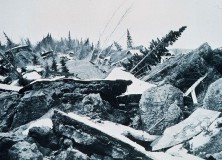1964 Alaskan Earthquake — Dwight A. Ink

INTRODUCTION:
In 1964, an earthquake struck Alaska that measured 9.2 on the Richter scale, the most severe ever recorded in North America. Transportation networks and critical infrastructure were almost entirely decimated, crippling Alaska’s feeble pre-oil economy. Nevertheless, federal, state and local bureaucracies rapidly and effectively collaborated to maintain Alaska’s viability as a state in the aftermath of the disaster. The case is of particular interest to the Project on National Security Reform (PNSR) due to the Johnson administration’s successful coordination of federal and state agencies in managing the relief and recovery efforts.
STRATEGY:
No recovery organization had existed prior to 1964. The Johnson administration therefore confronted the task of integrating national resources in an ad hoc fashion. The president created the Federal Reconstruction and Development Planning Commission for Alaska, a cabinet-level agency that developed a rehabilitation strategy and managed its implementation through an effective division of labor among the agencies most engaged in the recovery efforts.
INTEGRATED ELEMENTS OF NATIONAL POWER:
Backed by presidential authority, the commission expedited both policy and operational decision-making, encouraging cooperation among scores of government agencies. Eventually, virtually every government agency became involved in the commission.
The many specialized task forces supplemented the activity of the first responders in the Office of Emergency Preparedness (OEP) rather than attempting to supplant it. This non-hierarchical approach was essential to convincing the OEP to collaborate with the new commission.
EVALUATION:
Several variables explain the development and implementation of a successful recovery operation. At a decision making level, it was important that no single agency had clear authority over peer agencies. This approach facilitated the conceptualization of a unified strategy, while maintaining incentives for individual agencies to employ their resources most effectively. The simplicity of the organization and management approaches used by the Federal Reconstruction and Developing Planning Commission for Alaska not only allowed a high degree of flexibility in the implementation of broad federal objectives, but in combination with the unprecedented emphasis on rapid action, it also minimized the level of financial investment necessary for the recovery effort. Reliance on experienced career personnel to lead the execution of Commission policies also turned out to be crucial. The decision to involve the Alaskan populace actively in the recovery process also facilitated success during the implementation phase. Rather than retarding progress, involving affected Alaskans, as well as state and local agencies in the federal decision making inspired trust in the actions of the federal government, and saved both time and money.
RESULTS:
The earthquake imposed major costs on many Alaskans, but the effective recovery efforts obviated the need to activate the last-resort strategy of relocating much of the Alaskan population to other parts of the United States. The rehabilitation efforts allowed the state’s economy to survive the ordeal. These successes demonstrated how the federal, state and local governments can profitably collaborate with businesses and nonprofit groups as an integrated team even in the dace of a catastrophic disaster. Although each community faced unique challenges, the unprecedented management strategies adopted by the commission provided a framework under which diverse and timely solutions could be implemented very rapidly.
CONCLUSION:
Reconstruction efforts following the 1964 Alaskan earthquake showcased effective and swift collaboration between federal, state, and local agencies tasked with responding to a catastrophic natural disaster. Vesting officials with the ability to respond rapidly compressed most critical reconstruction into the first few months after the Alaska earthquake, minimizing the economic impact of the damage and allowing residents to remain in the state.